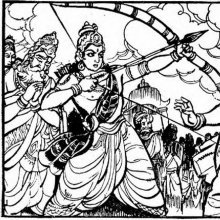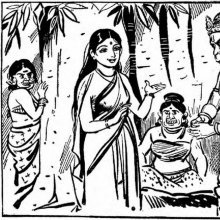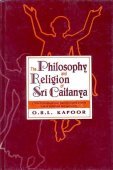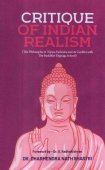Joy: 2 definitions
Introduction:
Joy means something in Buddhism, Pali, Hinduism, Sanskrit. If you want to know the exact meaning, history, etymology or English translation of this term then check out the descriptions on this page. Add your comment or reference to a book if you want to contribute to this summary article.
Images (photo gallery)
In Hinduism
Natyashastra (theatrics and dramaturgy)
Source: Shodhganga: Elements of Art and Architecture in the Trtiyakhanda of the Visnudharmottarapurana (natya)1) Joy (expression) is associated with Parivāhita: one of the “seven movements of the head” (in Sanskrit Dramas), as conveyed through Āṅgikābhinaya: one of the four divisions of Abhinaya or “ways to convey or represent one’s emotion to others”, according to the Nāṭyaśāstra and the Viṣṇudharmottarapurāṇa, an ancient Sanskrit text which (being encyclopedic in nature) deals with a variety of cultural topics such as arts, architecture, music, grammar and astronomy.—The āṅgikābhinaya includes the histrionic representation of the limbs which is simply known as physical gestures. In the Viṣṇudharmottarapurāṇa, seven types of movements of the head are recorded. The Parivāhita type of movement shows achievement, joy and sportiveness.
2) Joy (expression) is also associated with Prasārita: one of the “five kinds of side-movements”.—There are five kinds of side movements accepted in the Viṣṇudharmottarapurāṇa. The prasārita movement shows triumph, happiness and joy. The term prasārita means expanded.
3) Walking in Joy is associated with Śīghra-gati: one of the various Gatis (“way of walking”).—Śīghragati or quick gait should be adopted in fear, terror, anger, joy, rapid and urgent actions, on hearing distasteful information, on seeing unbelievable things, searching of crime factors etc. In the Mṛcchakaṭika of Śudraka, the heroin Vasantasenā was moving speedily in terror as she was followed by some cunning persons like Vīṭa, Ceṭa and Śakāra and her gait was crossing over the speed of wind. This can be taken as a manifestation of śīghra-gati.

Natyashastra (नाट्यशास्त्र, nāṭyaśāstra) refers to both the ancient Indian tradition (shastra) of performing arts, (natya—theatrics, drama, dance, music), as well as the name of a Sanskrit work dealing with these subjects. It also teaches the rules for composing Dramatic plays (nataka), construction and performance of Theater, and Poetic works (kavya).
In Buddhism
Theravada (major branch of Buddhism)
Source: Pali Kanon: Manual of Buddhist Terms and Doctrinessomanassa. - Altruistic j. = muditā (s. brahma-vihāra).
Theravāda is a major branch of Buddhism having the the Pali canon (tipitaka) as their canonical literature, which includes the vinaya-pitaka (monastic rules), the sutta-pitaka (Buddhist sermons) and the abhidhamma-pitaka (philosophy and psychology).
See also (Relevant definitions)
Starts with: Joy-ey, Joyain, Joyful men, Joyful women, Joyik, Joyisa, Joyisiga, Joyisitana, Joytishmati, Joyweed.
Ends with: Altruistic Joy.
Full-text (+2169): Ananda, Harsha, Mudita, Ullasa, Ahlada, Pramoda, Moda, Praharsha, Kilakila, Samharsha, Muda, Amoda, Prahlada, Sukha, Saccidananda, Anumodana, Priti, Samtosha, Kallola, Uddharsha.
Relevant text
Search found 365 books and stories containing Joy; (plurals include: Joies). You can also click to the full overview containing English textual excerpts. Below are direct links for the most relevant articles:
The Great Chariot (by Longchenpa)
Part 4 - The meditation of joy < [G. How to meditate]
H. Further explanation of the way of meditating < [Chapter VII - The Four immeasurables]
Part 3 - When the benefits have been explained, we arouse joy < [C. The nature of the environment and inhabitants of the phenomenal world]
A History of Indian Philosophy Volume 4 (by Surendranath Dasgupta)
Part 6 - Ultimate Realization < [Chapter XXXIII - The Philosophy of Jiva Gosvāmī and Baladeva Vidyābhūṣaṇā]
Part 7 - The Joy of bhakti < [Chapter XXXIII - The Philosophy of Jiva Gosvāmī and Baladeva Vidyābhūṣaṇā]
Part 2 - The Life of Caitanya < [Chapter XXXII - Caitanya and his Followers]
Cetasikas (by Nina van Gorkom)
Chapter 33 - Compassion And Sympathetic Joy < [Part IV - Beautiful Cetasikas]
Appendix 8 - Appendix To Chapter 31 < [Appendix And Glossary]
Chapter 11 - Enthusiasm < [Part II - The Particulars (pakinnaka)]
Abhidhamma in Daily Life (by Ashin Janakabhivamsa) (by Ashin Janakabhivamsa)
Factor 10 - Mudita (sympathetic joy) < [Chapter 3 - On kusala cetasikas (wholesome mental factors)]
Factor 11 - Upekkha (equminity) < [Chapter 3 - On kusala cetasikas (wholesome mental factors)]
Vimalakirti Nirdesa Sutra (by Charles Luk)
Maha Prajnaparamita Sastra (by Gelongma Karma Migme Chödrön)
II. Superiority of sypathetic joy over good action < [Part 1 - Surpassing the high qualities of the Śrāvakas]
Mahāyāna auxiliaries (F): The seven factors of enlightenment < [Part 3 - The auxiliaries according to the Mahāyāna]
I. Definition of sympathetic joy (anumodanā) < [Part 1 - Surpassing the high qualities of the Śrāvakas]
Related products







